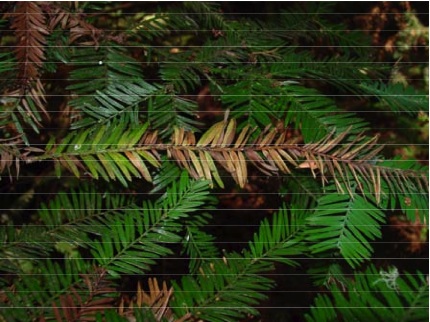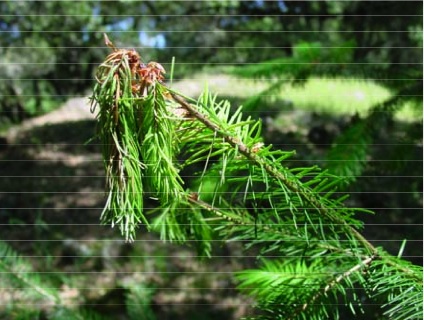PESTS AND DISEASES OF FORESTRY IN NEW ZEALAND
Phytophthora ramorum: a new threat to conifers in New Zealand?
Scion is the leading provider of forest-related knowledge in New Zealand
Formerly known as the Forest Research Institute, Scion has been a leader in research relating to forest health for over 50 years. The Rotorua-based Crown Research Institute continues to provide science that will protect all forests from damage caused by insect pests, pathogens and weeds. The information presented below arises from these research activities.
From Forest Health News No. 123, October 2002.

This time last year we featured the progress of a new disease in California and Oregon called sudden oak death, caused by the fungus Phytophthora ramorum (FHNews 113:1). Since then this disease has continued to spread, and is now known on 17 hosts. Last month P. ramorum was reported on two conifers, coast redwood (Sequoia sempervirens) and Douglas-fir (Pseudotsuga menziesii). However, although it has already killed tens of thousands of oaks (Quercus spp.) and tanoaks (Lithocarpus densiflorus), P. ramorum appears to have minimal impact on conifers, with only saplings so far being affected. In the case of coast redwood all saplings tested have proved positive for the presence of P. ramorum. Symptoms in this host are restricted to older needles and to small branches, whereas in oaks the fungus causes large trunk cankers.
With respect to Douglas-fir, infected saplings have been found at only one site, beneath heavily infected bay laurel (Umbellularia californica). This has led to speculation that these saplings are suffering from site specific stress and very high inoculum exposure, which has diminished their resistance and made them susceptible to fungal attack. The typical symptoms of disease in Douglas-fir are cankers on small branches, wilting of new shoots, and some dieback of branches. Symptoms have been induced experimentally in both Douglas-fir and coast redwood, but Californian researchers are uncertain as to the long-term consequences of the disease to the health of these species. At this stage only one mature conifer, a coast redwood, may have succumbed as a victim of this disease, but unfortunately this tree was cut down before any conclusive evidence could be gathered.

The virulence of P. ramorum suggests it may be an introduced pathogen, and United States authorities have introduced quarantine measures to restrict the movement of potentially infected plants. The US Forest Service believes that large areas in the east of the country are at risk where the climate would probably encourage the disease. The discovery of P. ramorum on conifers also raises biosecurity issues for forestry in New Zealand. Molecular and morphological diagnostic and identification techniques have been developed in California, and Forest Research is currently exploring links with the University of California at Davis and the Department of Agriculture, Fisheries and Forestry - Australia (AFFA) to establish a diagnostic and identification capability for sudden oak death and P. ramorum in Australasia.
(Geoff Ridley, Forest Research)
This information is intended for general interest only. It is not intended to be a substitute for specific specialist advice on any matter and should not be relied on for that purpose. Scion will not be liable for any direct, indirect, incidental, special, consequential or exemplary damages, loss of profits, or any other intangible losses that result from using the information provided on this site.
(Scion is the trading name of the New Zealand Forest Research Institute Limited.)

 Farm Forestry New Zealand
Farm Forestry New Zealand

